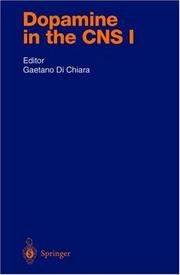| Listing 1 - 10 of 11 | << page >> |
Sort by
|
Dissertation
Year: 2013 Publisher: [S.l.] : [chez l'auteur],
Abstract | Keywords | Export | Availability | Bookmark
 Loading...
Loading...Choose an application
- Reference Manager
- EndNote
- RefWorks (Direct export to RefWorks)
Dopaminergic neurons --- physiology --- Dopaminergic Neurons --- physiology.
Dissertation
Abstract | Keywords | Export | Availability | Bookmark
 Loading...
Loading...Choose an application
- Reference Manager
- EndNote
- RefWorks (Direct export to RefWorks)

ISBN: 3540427198 3540427201 Year: 2002 Publisher: Berlin : Springer,
Abstract | Keywords | Export | Availability | Bookmark
 Loading...
Loading...Choose an application
- Reference Manager
- EndNote
- RefWorks (Direct export to RefWorks)
Central nervous system. --- Dopamine. --- Dopaminergic mechanisms. --- Dopaminergic neurons.
Book
Year: 2015 Publisher: Frontiers Media SA
Abstract | Keywords | Export | Availability | Bookmark
 Loading...
Loading...Choose an application
- Reference Manager
- EndNote
- RefWorks (Direct export to RefWorks)
Parkinson's disease is a neurodegenerative disorder that affects 1.5% of the global population over 65 years of age. The hallmark feature of this disease is the degeneration of dopamine neurons in the substantia nigra pars compacta and a consequent striatal dopamine deficiency. The pathogenesis of Parkinson's Disease remains unclear. Despite tremendous growth in recent years in our knowledge of the molecular basis of Parkinson's Disease and the molecular pathways of cell death important questions remain regarding why are substantia nigra cells especially vulnerable, which mechanisms underlie progressive cell loss or what do Lewy bodies or alpha-synuclein reveal about disease progression. Understanding the different vulnerability of the dopaminergic neurons from midbrain regions and the mechanisms whereby pathology becomes widespread are primary objectives of basic and clinical research in Parkinson's Disease. This e-Book discusses the etiopathogenesis of Parkinson's Disease, presenting a series of papers that provide up-to-date, state-of-the-art information on molecular and cellular mechanisms involved in the neurodegeneration process in the disease, the role of activation of functional anatomical organization of the basal ganglia and in particular habitual vs goal directed systems as a factor of neuronal vulnerability, the possibility that Parkinson's Disease coulb be a prion disease and how genetic factors linked to familial and sporadic forms of PD. We hope that this e-Book will stimulate the continuing efforts to understand the cell and physiological mechanisms underlying the origin of Parkinson's Disease.
Striatum --- synuclein --- Mitochondria --- Cell vulnerability --- Dopamine --- Substantia Nigra --- Dopaminergic Neurons --- Parkinson's Disease --- habitual behavior
Book
Year: 2015 Publisher: Frontiers Media SA
Abstract | Keywords | Export | Availability | Bookmark
 Loading...
Loading...Choose an application
- Reference Manager
- EndNote
- RefWorks (Direct export to RefWorks)
Parkinson's disease is a neurodegenerative disorder that affects 1.5% of the global population over 65 years of age. The hallmark feature of this disease is the degeneration of dopamine neurons in the substantia nigra pars compacta and a consequent striatal dopamine deficiency. The pathogenesis of Parkinson's Disease remains unclear. Despite tremendous growth in recent years in our knowledge of the molecular basis of Parkinson's Disease and the molecular pathways of cell death important questions remain regarding why are substantia nigra cells especially vulnerable, which mechanisms underlie progressive cell loss or what do Lewy bodies or alpha-synuclein reveal about disease progression. Understanding the different vulnerability of the dopaminergic neurons from midbrain regions and the mechanisms whereby pathology becomes widespread are primary objectives of basic and clinical research in Parkinson's Disease. This e-Book discusses the etiopathogenesis of Parkinson's Disease, presenting a series of papers that provide up-to-date, state-of-the-art information on molecular and cellular mechanisms involved in the neurodegeneration process in the disease, the role of activation of functional anatomical organization of the basal ganglia and in particular habitual vs goal directed systems as a factor of neuronal vulnerability, the possibility that Parkinson's Disease coulb be a prion disease and how genetic factors linked to familial and sporadic forms of PD. We hope that this e-Book will stimulate the continuing efforts to understand the cell and physiological mechanisms underlying the origin of Parkinson's Disease.
Striatum --- synuclein --- Mitochondria --- Cell vulnerability --- Dopamine --- Substantia Nigra --- Dopaminergic Neurons --- Parkinson's Disease --- habitual behavior
Book
Year: 2015 Publisher: Frontiers Media SA
Abstract | Keywords | Export | Availability | Bookmark
 Loading...
Loading...Choose an application
- Reference Manager
- EndNote
- RefWorks (Direct export to RefWorks)
Parkinson's disease is a neurodegenerative disorder that affects 1.5% of the global population over 65 years of age. The hallmark feature of this disease is the degeneration of dopamine neurons in the substantia nigra pars compacta and a consequent striatal dopamine deficiency. The pathogenesis of Parkinson's Disease remains unclear. Despite tremendous growth in recent years in our knowledge of the molecular basis of Parkinson's Disease and the molecular pathways of cell death important questions remain regarding why are substantia nigra cells especially vulnerable, which mechanisms underlie progressive cell loss or what do Lewy bodies or alpha-synuclein reveal about disease progression. Understanding the different vulnerability of the dopaminergic neurons from midbrain regions and the mechanisms whereby pathology becomes widespread are primary objectives of basic and clinical research in Parkinson's Disease. This e-Book discusses the etiopathogenesis of Parkinson's Disease, presenting a series of papers that provide up-to-date, state-of-the-art information on molecular and cellular mechanisms involved in the neurodegeneration process in the disease, the role of activation of functional anatomical organization of the basal ganglia and in particular habitual vs goal directed systems as a factor of neuronal vulnerability, the possibility that Parkinson's Disease coulb be a prion disease and how genetic factors linked to familial and sporadic forms of PD. We hope that this e-Book will stimulate the continuing efforts to understand the cell and physiological mechanisms underlying the origin of Parkinson's Disease.
Striatum --- synuclein --- Mitochondria --- Cell vulnerability --- Dopamine --- Substantia Nigra --- Dopaminergic Neurons --- Parkinson's Disease --- habitual behavior --- Striatum --- synuclein --- Mitochondria --- Cell vulnerability --- Dopamine --- Substantia Nigra --- Dopaminergic Neurons --- Parkinson's Disease --- habitual behavior

ISBN: 1573314498 Year: 2003 Publisher: New York (N.Y.) : New York academy of sciences,
Abstract | Keywords | Export | Availability | Bookmark
 Loading...
Loading...Choose an application
- Reference Manager
- EndNote
- RefWorks (Direct export to RefWorks)
Dopamine --- Dopaminergic mechanisms --- Dopaminergic neurons --- Parkinson Disease --- Parkinson's disease --- Parkinson's disease --- biosynthesis --- Molecular aspects --- Pathophysiology
Book
ISBN: 9780195373035 0195373030 Year: 2010 Publisher: Oxford OUP
Abstract | Keywords | Export | Availability | Bookmark
 Loading...
Loading...Choose an application
- Reference Manager
- EndNote
- RefWorks (Direct export to RefWorks)
Dopaminergic neurons --- Dopaminergic mechanisms --- Dopamine --- Brain --- Dopamine Agents --- Receptors, Dopamine --- physiology --- Biogenic amines --- Bromocriptine --- Catecholamines --- Neurotransmitters --- Dopamine neurons --- Neurons --- Sympathetic nervous system --- Dopaminergic neurons - Handbooks, manuals, etc. --- Dopaminergic mechanisms - Handbooks, manuals, etc. --- Dopamine - Handbooks, manuals, etc. --- Dopamine - physiology - handbooks --- Brain - physiology - handbooks --- Dopamine Agents - handbooks --- Receptors, Dopamine - handbooks
Book
ISBN: 1489981802 1441903216 9786612824739 1282824732 1441903224 Year: 2009 Publisher: New York, N.Y. : Austin, Tex. : Springer Science+Business Media ; Landes Bioscience,
Abstract | Keywords | Export | Availability | Bookmark
 Loading...
Loading...Choose an application
- Reference Manager
- EndNote
- RefWorks (Direct export to RefWorks)
Theneurotransmitter dopamine has just celebrated its 50thbirthday. The discovery of dopamine as a neuronal entity in the late 1950s and the notion that it serves in neurotransmission has been a milestone in the field of neuroscience research. This milestone marked the beginning of an era that explored the brain as an integrated collection of neuronal systems that one could distinguish on basis of neurotransm- ter identities, and importantly, in which one started to be able to pinpoint the seat of brain disease. The mesodiencephalic dopaminergic (mdDA) system, previously designated as midbraindopaminergic system, has received much attention since its discovery. The initial identification of dopamine as a neurotransmitter in the central nervous system (CNS) and its relevance to psychiatric and neurological disorders have stimulated a plethora of neurochemical, pharmacological and genetic studies into the function of dopamine neurons and theirprojections. In the last decade, studies on gene expression and development have further increased the knowledge of this neuronal population and have unmasked a new level of complexity. The start of the molecular dissection of the mdDA system has been marked by the cloning and characterization ofNurrl and Pitx3. These transcription factors were shown to have a critical function during mdDA development. These initial studies have been followed by the identification of many other proteins, which have a crucial function in the creation of a dopamine neuron permissive region, induction of precursors, induction of terminaldifferent- tion and finally maintenance of the mdDA neuronal pool.
Dopaminergic neurons. --- Dopaminergic neurons --- Neurotransmitter Agents --- Neurons --- Dopamine --- Physiology --- Catecholamines --- Biological Science Disciplines --- Molecular Mechanisms of Pharmacological Action --- Physiological Effects of Drugs --- Cells --- Nervous System --- Biogenic Monoamines --- Pharmacologic Actions --- Anatomy --- Natural Science Disciplines --- Amines --- Biogenic Amines --- Chemical Actions and Uses --- Disciplines and Occupations --- Organic Chemicals --- Chemicals and Drugs --- Neuroscience --- Human Anatomy & Physiology --- Health & Biological Sciences --- Dopamine neurons --- Medicine. --- Biomedicine. --- Biomedicine general. --- Clinical sciences --- Medical profession --- Human biology --- Life sciences --- Medical sciences --- Pathology --- Physicians --- Dopaminergic mechanisms --- Health Workforce --- Biomedicine, general.
Book
ISBN: 3211926593 9786612997990 1282997998 3211926607 Year: 2009 Publisher: Wien : Springer,
Abstract | Keywords | Export | Availability | Bookmark
 Loading...
Loading...Choose an application
- Reference Manager
- EndNote
- RefWorks (Direct export to RefWorks)
This book provides a unique and timely multidisciplinary synthesis of our current knowledge of the anatomy, pharmacology, physiology and pathology of the substantia nigra pars compacta (SNc) dopaminergic neurons. The single chapters, written by top scientists in their fields, explore the life cycle of dopaminergic neurons from their birth to death, the cause of Parkinson's disease, the second most common and disabling condition in the elderly population. Nevertheless, the intracellular cascade of events leading to dopamine cell death is still unknown and, consequently, treatment is symptomatic rather than preventive. The mechanisms by which alterations cause neuronal death, new therapeutic approaches and the latest evidence of a possible de novo neurogenesis in the SNc are reviewed and singled out in different chapters. This book bridges basic science and clinical practice and will prepare the reader for the next few years, which will surely be eventful in terms of the progress of dopamine research.
Dopaminergic neurons. --- Neurotransmitters. --- Parkinson’s disease -- Treatment. --- Substantia nigra. --- Dopaminergic neurons --- Substantia nigra --- Neurotransmitters --- Dopamine --- Parkinson Disease --- Substantia Nigra --- Physiology --- Neurons --- Catecholamines --- Neurodegenerative Diseases --- Biological Science Disciplines --- Cells --- Parkinsonian Disorders --- Tegmentum Mesencephali --- Nervous System --- Mesencephalon --- Anatomy --- Movement Disorders --- Biogenic Monoamines --- Natural Science Disciplines --- Basal Ganglia Diseases --- Amines --- Nervous System Diseases --- Brain Diseases --- Brain --- Disciplines and Occupations --- Central Nervous System Diseases --- Diseases --- Biogenic Amines --- Organic Chemicals --- Brain Stem --- Central Nervous System --- Chemicals and Drugs --- Neuroscience --- Neurology --- Medicine --- Human Anatomy & Physiology --- Health & Biological Sciences --- Black substance (Neuroanatomy) --- Body of Vicq d'Azyr --- Locus niger (Neuroanatomy) --- Nigra (Neuroanatomy) --- Nucleus niger (Neuroanatomy) --- Soemmering's ganglion --- Dopamine neurons --- Medicine. --- Neurology. --- Medicine & Public Health. --- Dopaminergic mechanisms --- Nervous system --- Neuropsychiatry --- Neurology .
| Listing 1 - 10 of 11 | << page >> |
Sort by
|

 Search
Search Feedback
Feedback About UniCat
About UniCat  Help
Help News
News